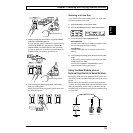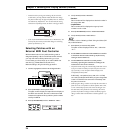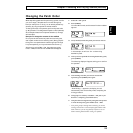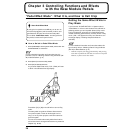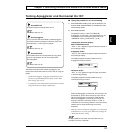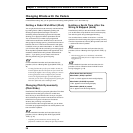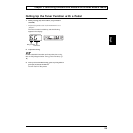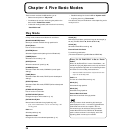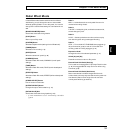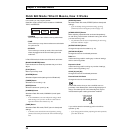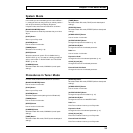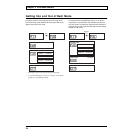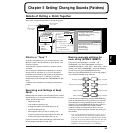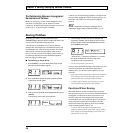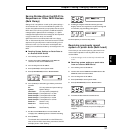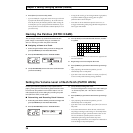
31
Chapter 4 Five Basic Modes
Chap.
4
Pedal Effect Mode
In Pedal Effect mode, buttons and dials work as follows.
Additionally, you can change the nature of the available
effects by pressing Pedals 1 to 4 in each patch. You can also
change and re-record effects settings in User Patches A11 to
d84.
[BANK/PARAMETER] Button
Goes forward and back through banks.
[PLAY] Button
Returns you to Play mode.
[SYSTEM] Button
Switches to System mode (settings for the GR-33 itself).
[TUNER] Button
Switches to Tuner mode (p. 18).
[WRITE] Button
Writes the contents of a patch (p. 36).
[COMMON] Button
Switches to Patch Edit mode, COMMON (overall patch
settings).
[TONE] Button
Switches to Patch Edit mode, TONE (sound-related patch
settings).
[EFFECTS] Button
Switches to Patch Edit mode, EFFECTS (effect-related patch
settings).
[STRING SELECT] Button
Has no function in this mode.
[OUTPUT SELECT] Button
Changes the output device selection (p. 19).
[PATCH/VALUE] Dial
Goes forward and back through patches (p. 23).
* If “DIAL FUNCTION” is set to “VALUE Only,” this will be
ignored.
Pedal 1
WAH → Adds effects such as a wah pedal-like sound or
mechanical-sounding vibrato.
Pedal 2
P-GLIDE → Adds pitch glide, an effect that creates wide,
smooth changes in pitch.
Pedal 3
HOLD → Causes synthesizer sounds to continue to play
even after the guitar string has stopped vibrating.
Pedal 4
CTRL → Turns the MULTI-FX BYPASS, the arpeggiator (p.
76) and harmonist (p. 80) on and off. Is also used as an
auxiliary pedal for holding arpeggios (p. 76).
Expression Pedal
Changes the value of the selected parameter (p. 47).
GK-2A [S1] and [S2]
Press either of these to return to Play mode.
External Bank Shift Pedal (Bank Up)
This is used for the arpeggiator’s Tap Tempo Teach function
(p. 79). Also toggles between major and minor when using
harmonist (p. 85).
External Bank Shift Pedal (Bank Down)
Returns sounds that have been changed with the wah
function back to the way they sounded when the patch was
first selected. (Returns to the original sound even after
normal patch-switching procedures.)



